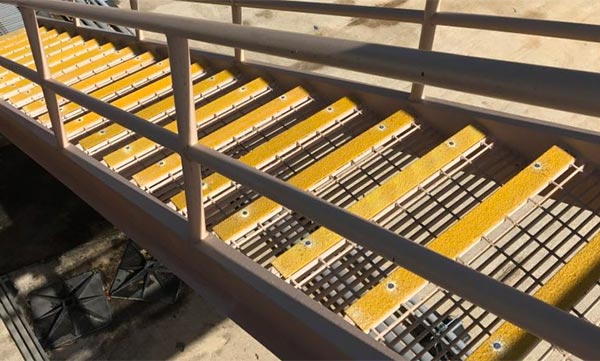Safety Concerns, Stairs & Decks
How to Make Outdoor Wood Stairs Less Slippery
As an affordable and broadly available building material, wood is widely used for exterior decks and stairs throughout the United States. Outdoor wood stairs, when pressure-treated wood is used, are expected to last 15-30 years on average. The most prominent agent that diminishes the lifetime of outdoor wood steps is the unavoidable moisture present outside. While moisture can severely alter the longevity of the wood stairs, it can also create hazardous slip and fall conditions.
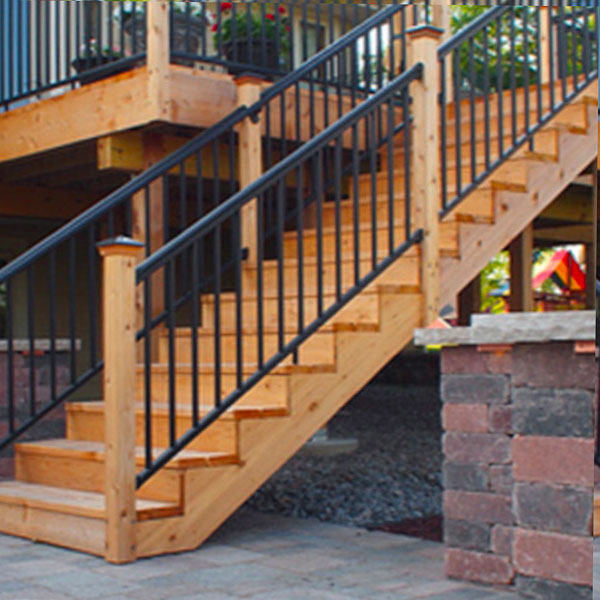
According to the World Health Organization, slips and falls are the second leading cause of unintentional injury death worldwide, meaning an average of 684,000 people die each year from fall-related injuries. With this danger looming in the yards of homeowners across the country, it is crucial to understand and prevent the most common causes of fall injuries on outdoor wood stairs.
Slip and Fall Hazards Caused by Moisture
Moisture on outdoor wood stairs can create a variety of dangerous slip, trip, and fall hazards. When water pools or seeps into the wooden stair treads, the stairs can warp and bow. Warped and bowed steps will no longer have a flat surface for walking and the bent stair treads can easily catch the side of a shoe, promoting dangerous trips and falls. Wood steps that are bowed also prevent water from correctly draining to the ground and can harbor a “bowl” of water. This collection of water may not be immediately visible to someone using the steps, and the puddle can cause a life-threatening slip.
Even when the wood steps are in prime structural condition, moisture in its many forms can create unavoidable slippery conditions. Outdoor stairs become increasingly slippery when wet, like after a morning dew or rainstorm. Climates like those in the Pacific Northwest of the United States are also prone to more rainstorms and lingering moisture. As explained in another blog post, although pressure-treated wood stairs are designed to outlast moisture, it can take a while for the leftover water to dry up, making them slippery. If the moisture is present on the wood for a prolonged period of time, mold, algae, and mildew can begin to form. These create a slimy film on top of the wood stairs that encourages slips, trips, and falls. The weather can also largely fluctuate during seasonal shifts, meaning moisture can appear when least expected. While the autumn temperatures may seem perfect for outdoor activities, the first frost that developed overnight and melted before morning makes outdoor wood stairs astonishingly slick and dangerous.

Painted or sealed outdoor wood stairs also create unsafe slip and fall conditions when moisture is present. Many homeowners choose to apply waterproof paint or sealant to their outdoor wood stairs in order to extend the lifetime of the wood and prevent mildew growth. While this is a helpful way to keep the wood in great condition, the paint or sealant does not provide any extra traction underfoot and they prevent any water from soaking into the wood. This means that water, like puddles leftover from a rainstorm, will sit on top of the painted or sealed wood until it naturally dries up. Stagnant water on top of wood stairs, even in just a thin layer of drops, can cause deadly falls.
Solutions for Slippery Outdoor Wood Stairs
There are a number of solutions that can be employed to help improve traction on slippery outdoor stairs. As with just about any measure to improve safety, there are trade-offs including effectiveness, longevity, aesthetics, and price.
Grit Treads and Tape
From a cost perspective, the use of grit treads and tape usually seem like the best option to improve traction on outdoor steps in wet conditions. Relatively inexpensive and easy to install, they’re often the first place homeowners turn.

Grit tape and treads will provide a nice amount of traction in slippery conditions caused by rain. Unfortunately, because these products were never intended for outdoor use, the grit treads and tape will peel away, often in less than a year. The natural expansion and contraction of wood break down the adhesion, leaving you with slippery stairs and peeling tape, which can create another slip and fall hazard.
Rubber Carpet or Treads
Another fairly inexpensive way to improve traction on wet steps is rubber or outdoor carpet mats. Typically, these 30 inch wide mats are a quarter-inch thick with a rubber backing to help reduce the inevitable slippage that occurs when placed on outdoor stairs. If your only slip and fall concern is water, these mats can be a viable solution. Unfortunately, when simply laid down and not permanently adhered to each stair, the tread can become a slip, trip, and fall hazard themselves.
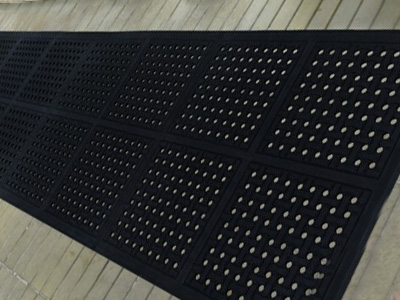
Because the rubber or carpet treads “float” on the stair, it’s relatively easy for you to catch a toe, potentially causing you to trip. Second, these mats can become an even larger problem if you live in areas where snow and ice are a concern. Not only can you not use a snow shovel to clear these mats because it will damage them, but they also tend to collect snow and ice, eliminating their non-slip properties.
Permanently Attached Non-Slip Stair Treads
Whether our HandiTreads, or alternatives from our competitors such as Dino Grip and Grip Strips, we believe the safest, most effective, and highest-value solution to slippery outdoor stairs are permanently installed non-slip treads.
While the initial investment in permanently installed treads is higher than grit tape or rubber mats, the enhanced safety, longevity, and maintenance-free benefits of permanently installed non-slip treads make them the most logical solution. Take, for example, our line of aluminum non-slip treads and stair nosings. Because they are made from hard-wearing aluminum, they will never rust even when exposed to constant moisture. Similarly, plastic GripStrips won’t rust because, well, they’re plastic!
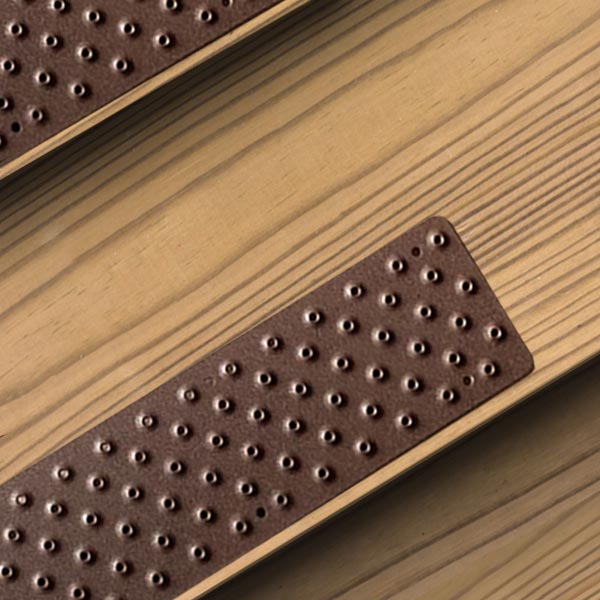
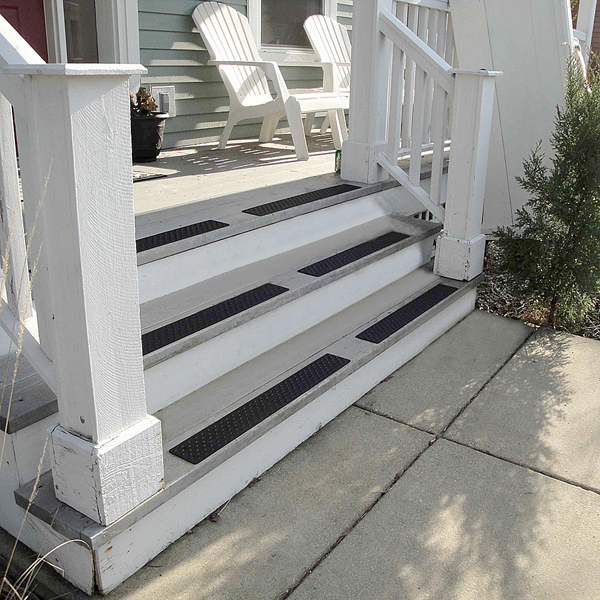
HandiTreads stair treads feature a patented anti-slip raised-button surface that provides superior traction in all climates and environmental conditions. The unparalleled design of the treads creates a solid grip between the surface and shoe while also dispelling any water or debris that may be present. HandiTreads are guaranteed to last a lifetime in residential applications.
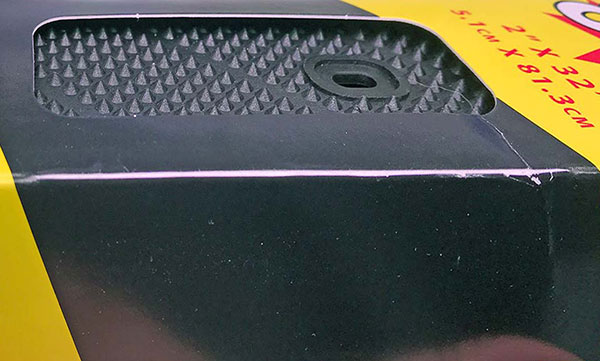
Dino Grip Mini Treads are constructed of a fiber-reinforced plastic base with a surface that’s coated with sealed grit. They appear to be quite durable, but there’s no indication on whether the stair treads can be shoveled from snow and look to be targeted at the commercial and industrial markets, not for homes. The mini treads come with a five-year warranty.
